Introduction of various intermediate wholesalers
Various Shops within the Fish Intermediate Wholesale Market
Various types of fishery products are brought into Toyosu Market from all over the world. Not only fresh fish, but also processed products are traded here, such as frozen, salted, sun-dried or minced fish. In the wholesale market, intermediate wholesalers evaluate and purchase those products.
And then, they carry the products to their shops, dividing them into proper quantities or sizes, display and sell them to the buyers.
It is said that about 480 kinds of fishery products are traded in Toyosu Market. Among the intermediate wholesalers, some shops handle a wide variety of the products as if they were museum of fish and seashells, but most of them trade only one kind or limited assortment.
They are categorized according to the products and each of them are called by the name unique to fish market.
Here we will introduce the major 10 categories in Toyosu Market.
Oh-mono : Literally meaning “large broad one” which actually means tuna.
In markets such as Toyosu Market, the term "oh-mono" is used for tuna, which are sold individually in auctions.
"Futo-mono" may be a more common term throughout Japan as a whole - it is used in areas to the west of the Kanto region (where Tokyo is located) as well as in Tohoku and Hokkaido.
Toyosu Market's oh-mono species mainly include tuna such as bluefin tuna, Southern bluefin tuna, bigeye tuna and yellowfin tuna, along with marlin such as swordfish and striped marlin.
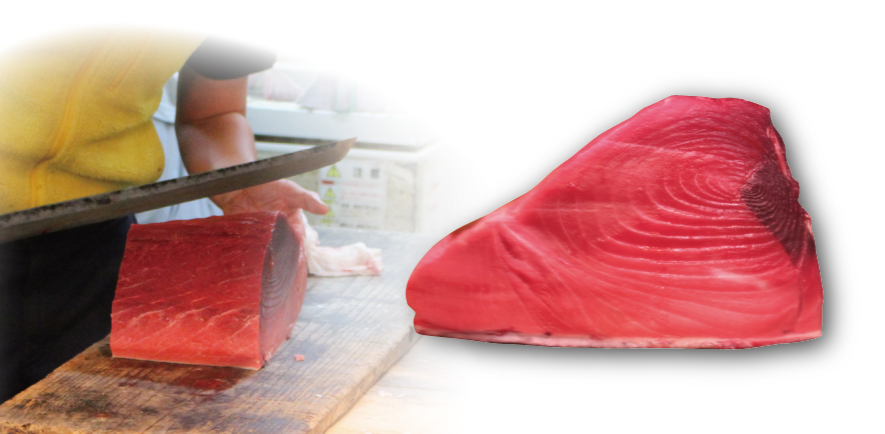
Sengyo : Fresh fish, from inshore, offshore and trawl fishery
Various species of fish such as mackerel, Atlantic horse mackerel, Pacific saury and sardines are caught in Japan's coastal waters and delivered fresh to Toyosu Market's fresh fish area.
The fish sold here used to be classified according to the region where they were caught, whether they were from inshore or offshore, and whether they were caught by trawl fishing, with intermediate wholesalers specializing in each category.
There was also a category called "aka-mono", a category of prized red fish such as red sea bream, which are eaten on special occasions. There were specialist intermediate wholesalers who only sold aka-mono.
These days, such specialists have all but disappeared, and our fresh fish stores sell a range of species from a variety of locations.
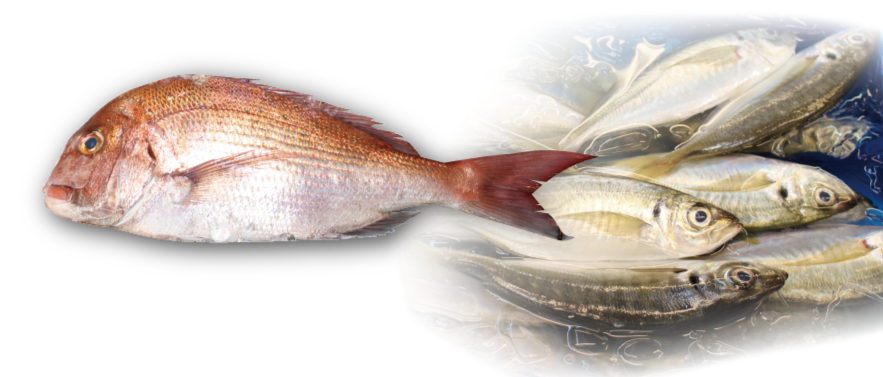
Tokusyu-mono : Specialties, as the finest seafood for sushi, tempura and high-end restaurants
The seafood used in sushi and tempura is called "sushi-dane" and "ten-dane".
Species range from dotted gizzard shad, Japanese halfbeak, abalone and scallops to Asian hard clams, sea urchins, sand-smelts and conger eels. These are all encompassed by the term "tokusyu-mono", specialty seafood used in restaurants such as sushi restaurants.
They also used to be referred to as "ko-mono" (small items) as all of these products are small.
Many of the tokusyu-mono found in intermediate wholesalers' stores are delivered and sold live (ike-mono).
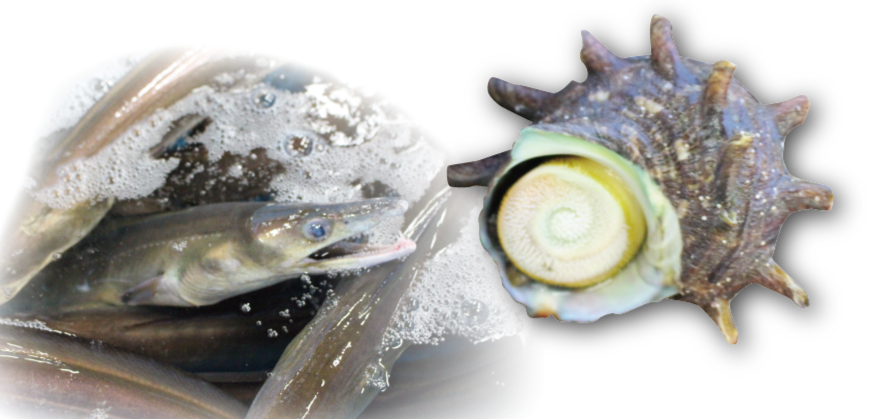
Ai-mono : Salted and semi-dried fish, such as sun-dried mackerel
"Ai-mono" generally refers to semi-processed or semi-fresh salted fish such as dried mackerel or Atlantic horse mackerel.
There are several theories about how ai-mono got its name. Some say the term originates from the Japanese verb "aeru", which refers to the application of salt to foods such as fish. Others believe that it comes from the word "aida" (between), since ai-mono are a category in between fresh fish and dried fish.
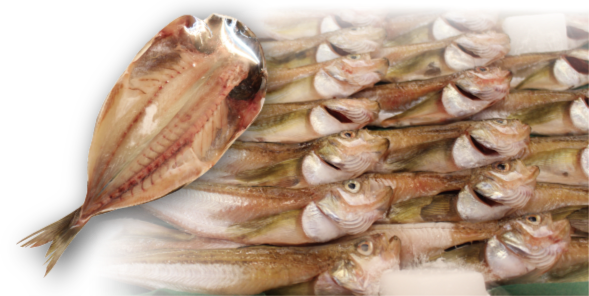
Enkan-mono : Salted and full-dried seafood, such as dried anchovy to extract soup stock
"Enkan-mono" simply means "salted and dried items", and true to their name, these products consist of salted and fully dried seafood.
Classic examples are surume (dried shredded squid), ni-boshi (dried sardines used for dashi stock) and shirasu-boshi (dried whitebait, which is eaten as a snack in its own right.)
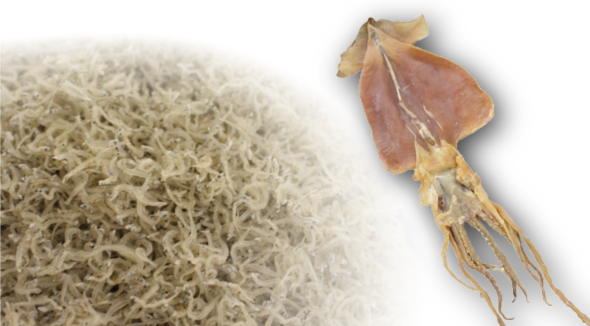
Hokuyo-mono : Fish and fish eggs from the North Pacific, such as salmon, cod and herring
Hokuyo-mono refers to seafood that is mainly caught in northern waters (the northern area of the Pacific Ocean and marginal seas such as the Bering Sea and the Sea of Okhotsk). These include salmon, trout, Alaska pollock, Pacific herring, crab and the roe of the fish caught (salmon roe, pollock roe, herring roe, etc.)
As this seafood comes from further north, much of it is salted or frozen.
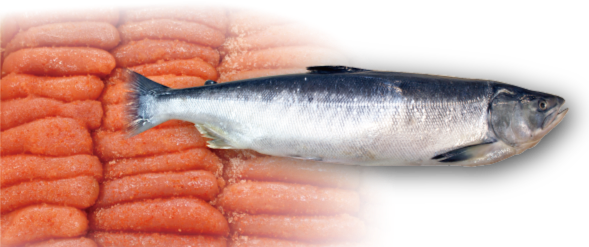
Neri-mono : Processed seafood made from fish mince or paste, such as Kamaboko or Satsuma-age
"Neri-mono" (or "neri-seihin") refers to processed products made by kneading fish paste called surimi, such as kamaboko (cured surimi) and satsuma-age fish cakes. It is usually written with the character for "knead", but in markets it is sometimes written with the character for "kneading over fire", since surimi is made by kneading (mashing) the flesh of the fish and heating it.
The intermediate wholesalers selling neri-mono also carry a wide range of processed products made from a variety of seafood.
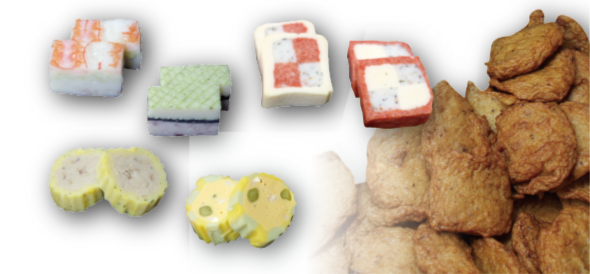
Ebi : Various prawn and shrimp, Japan’s favorite seafood
Prawns are one of the most common types of seafood in Japanese cuisine, used in dishes such as tempura and fried shrimp. Japan is said to be a major consumer of shrimp compared to the rest of the world.
Toyosu Market sells a wide variety of prawns.
Japanese species include Japanese tiger prawns, Japanese spiny lobsters, Alaskan pink shrimp, Botan shrimp, Sakura shrimp and Shiba shrimp.
Overseas species include black tiger prawns, white tiger prawns and king prawns. These come from Southeast Asia and various other parts of the world, and tend to be delivered frozen.

Tako : Octopus, which Japan consumes the most in the world
Octopus is a traditional part of Japanese cuisine, and Japan is the biggest consumer of octopus in the world.
The most commonly eaten species are the common octopus and the North Pacific giant octopus.
Akashi in Hyogo Prefecture and Sashima in Kanagawa Prefecture are the most famous suppliers of the common octopus in Japan, but common octopuses are also imported from West African countries such as Morocco, Mauritania and Senegal to keep up with Japan's demand.
The North Pacific giant octopus is an extremely large octopus that can reach a weight of over 10kg. It is used in products such as su-dako (pickled octopus).
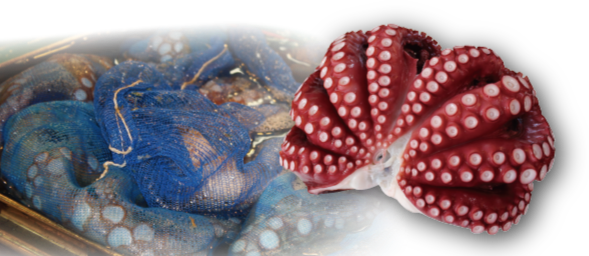
Tansui-gyo : Freshwater fish inhabited in rivers and lakes, such as eel, Ayu and soft-shelled turtle
Freshwater products are species from bodies of fresh water such as rivers and lakes.
In addition to eel, ayu and soft-shelled turtle, Toyosu Market sells species such as freshwater shrimp and Japanese freshwater crab.
Our eels and soft-shelled turtles reach the market live and are prepared for cooking in stores when they are ordered.
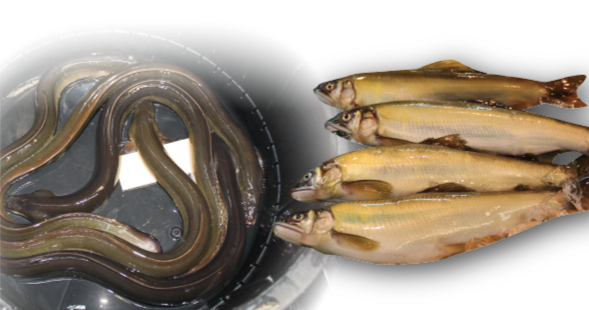
Fish Intermediate Wholesale Market

